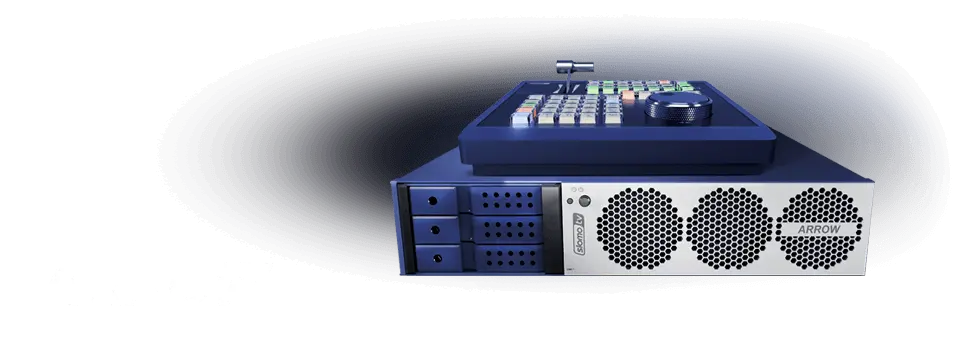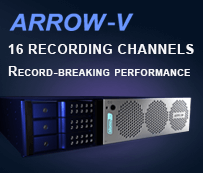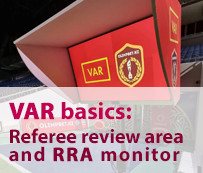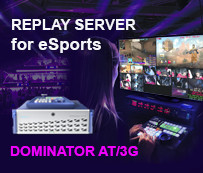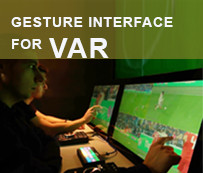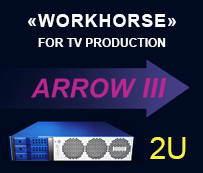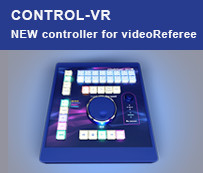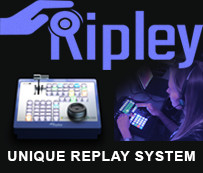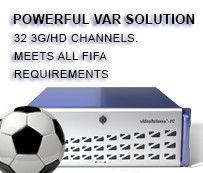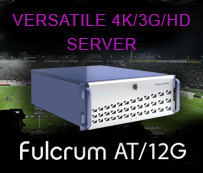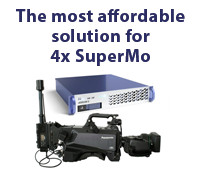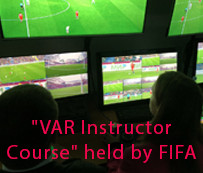Replay mode
User-friendly high-performance interface
Thanks to the world's fastest and most productive system interface, replay operators can work single-handedly with all the recording channels, having time not only to prepare replays, but also to make Summary/Highlights.
The system interface is designed so that the operator's attention is always focused on the monitor. Live windows, service information, clip playback information and other necessary data are always in front of the operator's eyes.
Simultaneous search on all channels
Due to the unique architecture of the systems, the search is not carried out on a separate SDI output, but on all channels simultaneously in the main GUI or Multiviewer. Replay operator easily switches attention from one channel to another controlling all channels, which saves a huge amount of time.
Automatic playlist creation during Instant Replays
In Instant Replay mode, the system automatically creates playlists from clips that were aired. This makes it possible to create Highlights/Summary much faster.
Quick creation of clips
A qualified operator needs 1.5 times less time to create and save clips on the slomo.tv system than on other servers.
Working with 2 separate playlists
Slomo.tv servers are able to save created clips to 2 separate active playlists. There is no need to upload another playlist every time you want to save clips into it.
Huge number of clips
In slomo.tv systems, there is virtually no limit on the number of clips that can be created.
Working with playlists
Simple and intuitive interface for creating and editing playlists provides the ability to change position of clips, copy and delete them without calling up additional functions. It is also possible to add clips to the playlist while playing.
Hotkeys
The hotkeys allow quick access to hundreds of objects - clips or playlists. Pressing 2-3 buttons provides access to any of these "quick" objects.
Networking
The Transfer function included in all slomo.tv servers provides exchanging of clips and playlists between slomo.tv servers on a local network. This allows scaling Production and using clips from servers working with SSM cameras to create Summary/Highlights without additional hardware or software. It is also possible to set up automatic transfer of all created clips and playlists to the designated server.
SSM cameras support
The Arrow servers are integrated with Super Slow Motion cameras from most manufacturers, providing support for 2x, 3x, 4x SuperMo (e.g. Panasonic AK-UC4000), Xtra Motion 6x (GVG LDX-86 HS/XS) and HyperMotion (1000 FPS Ikegami HiMotion-II) cameras. The number of required SDI inputs depends on the camera's shooting speed.
772 configuration for 662 system
For 662 system users, a 772 mode (7 Rec + 7 Search + 2 Play + FX) is available. In this configuration Preview via separate SDI output is not available. The remaining SDI output is used for the Program. Preview window is a standard element of the main interface. If needed, the Multiviewer can be configured to display the Preview.
Export and import of clips and playlists
The software allows exporting playlists and clips without any external equipment. Clips and playlists created while working in Instant replay mode can be exported as one file or as clip files with markups. Import is made with standard codecs from any file media or via network.
Export/Import of Playlists by Clips
This function facilitates the creation of final Summary/Highlights in multi-day competitions. At the end of the day, the Playlists can be exported by clips, with the clip's name indicating the duration and effects. For final Summary the previously exported Playlists are imported to the server and the best moments are selected. Export and Import are made to / from any file media or via network.
Built-in and a dedicated Multiviewer
The presence in the main interface of a built-in Multiviewer allows the operator to keep an eye on all channels. All indicators, controls and video windows, including search channels, are always before the operator's eyes. The dedicated Multiviewer is connected via the graphic port or via a free SDI output. Multiviewer has different video window layouts.
MultiSkin function
This feature allows the operator to use one monitor to display different interfaces and switch between them: Main Interface or Multiviewer or Game Analyzer (Telestrator).
Game Analyzer (Telestrator)
All servers have support for the Telestrator to impose simple graphic elements (lines, arrows, curved arrows, circles, etc.) and free drawing on video. It allows performing server-side moment analysis. The large number of graphics ports allows using the Telestrator on a separate HDMI monitor with built-in "pen" interface. If no such monitor is available, you can use a standard monitor and mouse.
2 graphics ports
The two configurable graphic ports allow setting up each of them to display different types of interfaces:
- Main interface
- Multiviewer
- Game Analyzer
This provides comfortable work for the operator if there is enough space available.
Multipurpose use of the 2nd SDI output. Alpha-channel
In case of using 2 SDI outputs, the second output can be configured as Preview (basic), Multiviewer or Alpha channel output. Alpha-channel is used for playback of prepared videos or graphic files, which were imported to the server.
Control ZR replay console
Designed for maximum speed and efficiency. It has 51 RGB backlit buttons with light and color indication, providing hints for the operator. The control panel provides direct access to 24 cameras in replay mode.
The T-bar provides over 1000 values of lever position. The console comes with slomo.tv's specialized Jog/Shuttle. The Shuttle wheel has 64 left and right positions, which allows you to control the search speed and the playback speed. Control console can be connected via RS-232/422, USB and Ethernet. It is powered by PoE or by USB (reduces the brightness of the buttons).
SSD-based subsystem
The use of SSD makes the systems more robust and efficient, especially when searching on all channels simultaneously. The server instantly responds to control commands. It also reduces the weight of the server and makes it more resistant to mechanical impacts and heavy vibration.
Protection of recorded material
Slomo.tv's highly reliable video recording format allows protecting the material in case of unexpected situations, such as power loss. All clips and playlists created by an operator are restored at restart.
Project workflow
Each operator works with his own project. The system reserves a configurable amount of storage space for each Project (Match). This allows you to split a large number of clips created, for example, during a long competition day. Each project can be password protected from accidental overwriting or deletion, and can be promptly loaded when needed to create/export a Summary for the event.
Recording for NLE
DMR™ (Direct Movie Record) – Multi-channel recording direct in NLE native files to removable HDD/SSDs and to the built-in storage
When using the DMR™, the server records video from SDI inputs with a selected codec to a built-in video array in a fail-safe high reliability file format and in native files of NLE systems on any available file storage. Typically, recording is performed on 3.5" SATA HDDs or SSDs (using SSDs adapters) installed in specialized Toolless/Trayless Racks or NAS. Supported codecs are: ProRes; AVID DNxHD; DVCPro HD; DVCPro 50; IMX; XDCAM 50; AVC-Intra 100/XAVC.
Thanks to the parallel recording to the built-in array and to file media, the material is duplicated. In case of loss of material on NAS or removable drives, the user can export recorded materials from the built-in array.
In contrast to the vast majority of other solutions, slomo.tv's servers are self-sufficient and do not require additional equipment (XFile, IPDirector) for multi-channel recording.
SD Proxy files
DMR™ technology provides simultaneous recording of both full resolution video files and SD Proxy files, which significantly increases the speed and comfort of editing.
Built-in DMR™ Racks
The most common and inexpensive 3.5" SATA hard drives or fast SSDs (adapters required) are used for video export/import and for direct recording for NLE. Specialized DMR™ Racks are located on the front of the server and require no additional tools to install the drives.
Export to XDCAM 50
All servers have a built-in export for subsequent editing with XDCAM 50 codec.
Additional features
Video-refereeing
The Arrow servers can be used as a Video Assisted Review system with 4-16 cameras (VAR, Videogoal, video-refereeing in many sports). The videoReferee® option allows reviewing controversial moments from up to 4 cameras simultaneously, frame-by-frame analyzing or playback with adjustable speed.
Redundant power supply
All Arrow servers can be ordered with a redundant power supply.
VideoServer – Delayed Out
This function allows setting a constant delay for Program/Out. This feature is actively used in live broadcasting and reality shows for monitoring and operative editing.
Optimized number of connections
Compact size of servers is achieved due to the fact that bi-directional SDI I/O are used. While 2 connections can be used for outputting Program and Preview in Replay mode, all connections can be used as video inputs in recording for editing or video-refereeing modes.


